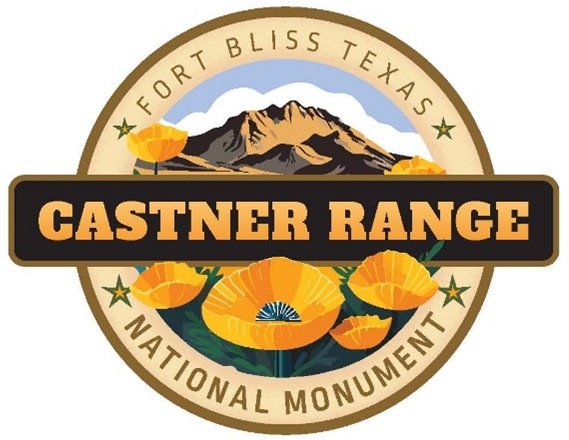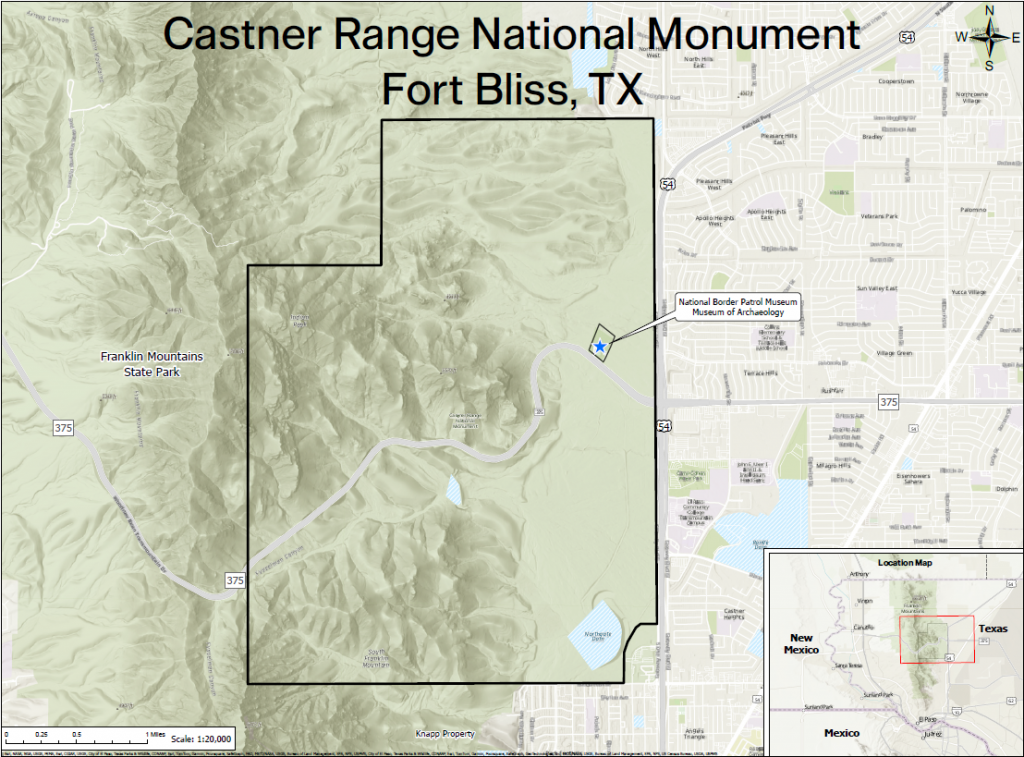Welcome to Castner Range National Monument!

Castner Range National Monument (the Monument) has the unique distinction as the only National Monument under United States Army (Army) management. It encompasses 6,672 acres on the eastern slopes of the Franklin Mountains on lands administered by Fort Bliss, El Paso, Texas. The Monument serves as a tribute to our nation’s Veterans, preserves significant cultural resources, rare and fragile natural resources, distinctive geological features, and sites of cultural significance to Tribal Nations. One of the last remaining undeveloped areas in the El Paso region, the Monument provides a special opportunity to conserve a natural landscape that is representative of the Chihuahuan Desert ecosystem.
The Army used the land for live-fire training until the 1960s and consequently, military munitions remain on much of the Monument. Although no longer used for training, the Army will continue to execute its environmental cleanup responsibilities in a manner that protects the objects of historic and scientific interest and leverage its strong relationships with the El Paso community. Not only was the protection of the Monument’s natural and cultural resources paramount, but preserving open space was also a focal component of the grass roots effort led by the local community to preserve this land.
Safety is our top priority. Currently, the Monument is closed to public access while the Army conducts a comprehensive munitions cleanup effort from previous military training and implements necessary precautions to ensure future access meets strict safety standards. Due to the complexity and magnitude of the cleanup, it will be several years before the Monument is safe for public access.
The Monument is significant because of its valuable combination of historical and ecological resources, which provide an opportunity for education, research, and recreation, while also preserving the area’s natural and cultural heritage for future generations. Successful management and stewardship of the Monument will require collaboration between Tribal Nations, local, state, and federal government agencies, the El Paso and surrounding communities, and conservation organizations.
- Military History: The Monument is an important part of the history of the United States military, with military training dating back to 1926. The Army established Castner Range when the 1st Cavalry Division was at Fort Bliss, who used it heavily through WWII (in particular the 82d Field Artillery Regiment) and ceased small arms range and artillery live-fire training in 1966.
- Natural Resources: This landscape has greatly reverted to natural conditions and is a natural haven for flora and fauna of the Chihuahuan Desert. The Monument is home to a variety of native species, including the Texas Horned Lizard, desert mule deer, golden eagles, and many other resident and migratory birds. It also supports seasonal wildflower blooms, most notably the vibrant Mexican Gold Poppies that attract visitors and photographers in springtime.
- Cultural Resources: The Monument has cultural and natural features, including archaeological sites, landscapes, objects, plants, and animals, often used at the center of time-honored traditions and stories of sacred significance to Tribal Nations. The continuum of human use and cultural ties are revealed by rock art, lithic scatters, and burial grounds.
- Research and Education Opportunities: The Monument provides opportunities for research and education and serves as a living outdoor classroom for studying its natural and cultural resources.
What’s New
Castner Range Map

3R’s

Access to Castner Range National Monument is currently restricted while the Army completes the cleanup process.
Always follow the Army’s 3Rs (Recognize, Retreat, and Report) of Explosive Safety:
- Recognize: when you may have encountered a munition and that munitions are dangerous.
- Retreat: do not approach, touch, move, or disturb the item, but carefully leave the area.
- Report: call 911 and advise the police of what you saw and where you saw it.
What is CERCLA and how does it relate to the Monument?
The Comprehensive Environmental Response, Compensation, and Liability Act (CERCLA) is a federal law that mandates the cleanup of hazardous substances. For the Monument, the Army is using this process to address munitions and other hazards to ensure the area is safe for public access. The CERCLA cleanup process will determine which areas of the Monument are ultimately safe for public access.
The CERCLA process includes Feasibility Studies, Proposed Plans, and Decision Documents. The Army will develop Proposed Plans upon completion of each of the three Feasibility Studies for the Monument. The Proposed Plans will identify the possible remediation alternatives within Castner Range and is coordinated with regulators. The public will have the opportunity to comment on Proposed Plans and the Army will consider all comments, incorporate changes as appropriate, and publish the final Proposed Plan.
As the final step in the CERCLA planning process before remedy implementation, the Army will develop applicable Decision Documents based on a corresponding final Proposed Plans and its supporting data and information. Decision Documents undergo in depth review and analysis by subject matter experts. Input received from the public, including review of potential future site uses, will be considered by the Army. Within a final Decision Document, the Army selects the Remedial Action that will take place, explains the action, certifies that the selection process was done in accordance with the law, and sets forth the rationale for the remedial work that will be conducted. These efforts aim to make the Monument safe for public access while protecting people’s health and the environment.

Opportunities for Public Involvement:
For each of the CERCLA Proposed Plans, there will be a minimum 30-day public comment period and opportunity for a public meeting to gather input on the Proposed Plan. The Army will consider all comments and incorporate changes as appropriate in the final Proposed Plan.
Additional opportunities for public participation will occur during the development of the Castner Range National Monument General Management Plan. The General Management Plan is a long-term management plan that sets the goals and allowable uses for the Monument.
Future Plans
The Army will continue to remove munitions on Castner Range, a process that will take many years to fully complete. As areas are made safe for public entry, the Army will analyze the public access opportunities.
